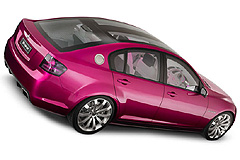Make / Model Search
News - HoldenIt’s official: Holden goes global!Made in Australia: GM's Gene Stefanyshyn will lead the Holden engineering group responsible for developing architechtures for models sold globally. Holden confirmed as vehicle architecture supplier to the General Motors world19 Jan 2005 HOLDEN will be responsible for developing the technology that will underpin up to half a million vehicles globally within a few years. Fishermen’s Bend has long been touted by its parent company as a "centre of rear-wheel drive excellence" within the General Motors world, and speculation about which GM vehicles Holden would be involved in engineering has been rife since Holden developed the Zeta architecture upon which next year’s redesigned VE Commodore will be based. But an internal GM memo last Tuesday confirmed Holden will be the engineering centre responsible for developing the platform architecture that will form the basis of large and long-wheelbase GM vehicles worldwide - from the 2007 Buick Velite convertible (above right) to perhaps even Saab’s next-generation 9-5 luxury sedan. While the statement is largely a formalisation of arrangements that have been planned for some time, it confirms Holden’s unprecedented status as an architectural development centre for GM and begins a process that will see Holden’s engineering expertise exported globally. Never before has Holden had responsibility for a global vehicle architecture, nor played such an integral part in GM’s global production process. The January 11 memo, which came to light last week via the overseas industry journal Autonews, names Gene Stefanyshyn – currently the vehicle line executive for GM's Epsilon front-drive, mid-sized car architecture - as the vehicle line executive for a new Port Melbourne-based architectural development centre, or "homeroom". The Port Melbourne homeroom will be responsible for developing GM’s Zeta rear-wheel drive architecture, while Jerry Gillespie will be VLE for GM’s Theta mid-sized SUV architecture in the US (with assistance from GM Daewoo Auto and Technology) and Randy Schwarz will continue to lead the engineering team for GM’s premium Sigma rear and all-wheel drive Cadillac models. While Tony Hyde remains Holden’s director of engineering, GM will appoint a chief engineer for each homeroom within a month and is scheduled to announce two further architectural centres by June. It is expected one of these will be responsible for GM’s new low-volume rear-drive architecture known as Kappa and which underpins the 2006 Pontiac Solstice, Chevrolet Nomad concept and the Saturn Curve concept. Kappa-based chassis and suspension components were also used underneath Holden’s stunning Torana TT36 concept car (pictured below) unveiled at the Australian International Motor Show last October, and at the time GM product boss Bob Lutz told GoAuto the concept could form the basis for a new medium-car RWD architecture – possibly known as Beta, according to one source – that Holden would also develop for the GM world. "If that thing really touches a nerve at the Sydney show and gets a lot of international attention, and we get a lot of people saying ‘oh why don’t you do that’, then we’ll take a look at it," Mr Lutz said. Holden sources now indicate, however, that Australia’s global architectural work will not go beyond the large-car Zeta platform, and as a consequence the production future of the Torana remains in doubt. While production capacity limitations mean Holden is unlikely to manufacture Zeta-based vehicles other than VE Commodore and its long-wheelbase WM Statesman/Caprice derivative, the Port Melbourne plant will be responsible for engineering a range of Zeta-based models around the world.  Holden will not divulge financial details of the new department other than confirming it "will be appropriately resourced". Nor is it clear how the wholly-owned GM subsidiary will receive long-term benefit in return for its ongoing supply of intellectual property, an issue GoAuto believes was a sticking point with previous Holden boss Peter Hanenberger. Holden will not divulge financial details of the new department other than confirming it "will be appropriately resourced". Nor is it clear how the wholly-owned GM subsidiary will receive long-term benefit in return for its ongoing supply of intellectual property, an issue GoAuto believes was a sticking point with previous Holden boss Peter Hanenberger.But Holden, which has already developed the Zeta components for use beneath VE Commodore, makes it clear the GM homeroom process will have advantages for its consumers. "When you’re the world’s largest car company it makes sense to reduce costs and the cost savings we can realise by sharing design and intellectual knowledge are significant," Holden spokesman Jason Laird told GoAuto. "Effectively, we’re able to tap into what’s happening elsewhere in a more formal way. Sourcing a particular component, for example, becomes less expensive when it’s used by so many vehicles. "Put simply, it enables us to deliver improved cars to market more cost effectively, rather than continuing along with company divisions or regional divisions," he said. Mr Laird said Holden believes the cost advantages of sharing its technology with the GM world far out-weighed the disadvantages of such a venture, in terms of increased component commonality across a wide range of GM models. "The beauty of global architectures is that the basis can be applied to the requirements of a particular brand while maintaining the essence and individuality of each brand. It has no impact on what the customer sees. At end of day the customer not interested in architectures," he said. While there is no mention of all-wheel drive (other than for Cadillac models) in the GM memo, Zeta architecture can be formatted in rear-wheel drive, all-wheel drive, with V6 and V8 drivetrains, and in a variety of wheelbases. Bob Lutz is on record as saying the Australian-designed Zeta architecture has a "huge" future and could underpin up to 400,000 new vehicles annually. VE Commodore and its derivatives will be the first Zeta-based production vehicles when they roll off Holden’s Elizabeth production line in the first half of next year, before more Zeta-based vehicles reach production readiness at GM’s Buick plant in Oshawa, Canada in 2006. The Zeta-based Buick Velite convertible that follows them into production in 2007 may be a relatively low-volume model (it does, however, prove the next Commodore’s architecture also brings the possibility of a convertible), but in 2002 Buick built 215,727 Buick Century and Regal models at Oshawa. While nobody at GM is willing to name models or production numbers, when you add domestic and export Commodore numbers to the Buick, Pontiac and Chevrolet models likely to employ Zeta for the world’s largest car market, then throw in Zeta-based replacements for Saab’s 9-5 and Opel’s Omega (the latter previewedby the Insignia concept car pictured top left, and could end up being a rebadged version of the VE Commodore), Holden-designed Zeta hardware could easily underpin 500,000 new vehicles globally every year. |
Click to shareHolden articlesResearch Holden Motor industry news |









Facebook Twitter Instagram